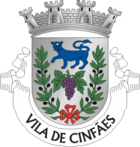Cinfães
| Cinfães | ||||||
|---|---|---|---|---|---|---|
|
||||||
| Basic data | ||||||
| Region : | Norte | |||||
| Sub-region : | Tâmega e Sousa | |||||
| District : | Viseu | |||||
| Concelho : | Cinfães | |||||
| Coordinates : | 41 ° 4 ′ N , 8 ° 5 ′ W | |||||
| Residents: | 3395 (as of June 30, 2011) | |||||
| Surface: | 25.42 km² (as of January 1, 2010) | |||||
| Population density : | 134 inhabitants per km² | |||||
| Cinfães district | ||||||
|
||||||
| Residents: | 20,427 (as of June 30, 2011) | |||||
| Surface: | 239.27 km² (as of January 1, 2010) | |||||
| Population density : | 85 inhabitants per km² | |||||
| Number of municipalities : | 14th | |||||
| administration | ||||||
| Administration address: | Câmara Municipal de Cinfães Paços do Concelho 4690-030 Cinfães |
|||||
| President of the Câmara Municipal: | Prof. José Manuel Pereira Pinto ( PS ) | |||||
| Website: | www.cm-cinfaes.pt | |||||
Cinfães is a small town ( Vila ) and a district ( Concelho ) in Portugal with 3395 inhabitants (as of June 30, 2011).
history
Megalithic systems and other finds prove a prehistoric settlement of the area. People of the Castro culture and nomads from North Africa, especially Berbers , settled here before the 9th century BC. Celtic Lusitanians arrived here and built fortified Iron Age villages.
From the 2nd century BC The Romans ruling here Romanized the fortified settlements and built bridges and Roman roads . After the Alans , Suebi and Vandals took over the area from the Romans in 409, the Visigoths conquered the present-day district from 456 . Little striking finds have remained from this era. From 711 the Moors conquered the peninsula. In addition to the excavations of oil mills, various place names have remained in the district from this period, such as Boassas or Saímes.
The place experienced its most important period during the Reconquista , as evidenced by a number of sacred buildings , such as the monastery and church of Tarouquela . The first Portuguese king, D. Afonso Henriques, probably spent part of his youth in Santiago de Piães , where he received training from Egas Moniz .
King Manuel I granted Cinfães city rights in 1513 .
administration
circle
Cinfães is the seat of a district of the same name. The neighboring districts are (starting clockwise in the north): Marco de Canaveses , Baião , Resende , Castro Daire , Arouca and Castelo de Paiva .
With the territorial reform in September 2013, the municipalities ( Freguesias ) Alhões , Bustelo , Gralheira and Ramires were merged to form the new municipality União das Freguesias de Alhões, Bustelo, Gralheira e Ramires . Since then, the district has consisted of the following 14 municipalities:
| local community | Population (2011) |
Area km² |
Density of population / km² |
LAU code |
|---|---|---|---|---|
| Alhões, Bustelo, Gralheira e Ramires | 595 | 37.52 | 16 | 180418 |
| Cinfães | 3,395 | 25.42 | 134 | 180403 |
| Espadanedo | 1,318 | 5.30 | 248 | 180404 |
| Ferreiros de Tendais | 695 | 16.00 | 43 | 180405 |
| Fornelos | 703 | 10.08 | 70 | 180406 |
| Moimenta | 408 | 6.54 | 62 | 180408 |
| Nespereira | 1,977 | 35.99 | 55 | 180409 |
| Oliveira do Douro | 1,529 | 14.13 | 108 | 180410 |
| Santiago de Piães | 1,797 | 17.59 | 102 | 180412 |
| São Cristóvão de Nogueira | 1,930 | 18.15 | 106 | 180413 |
| Souselo | 3,202 | 9.17 | 349 | 180414 |
| Tarouquela | 1,242 | 6.64 | 187 | 180415 |
| Tendais | 807 | 31.77 | 25th | 180416 |
| Travanca | 829 | 4.97 | 167 | 180417 |
| Cinfães district | 20,427 | 239.27 | 85 | 1804 |
Population development
| Population in the county of Cinfães (1801–2011) | |||||||||
|---|---|---|---|---|---|---|---|---|---|
| 1801 | 1849 | 1900 | 1930 | 1960 | 1981 | 1991 | 2001 | 2011 | |
| 2,687 | 7.125 | 25,631 | 30,080 | 29,757 | 25,619 | 23,489 | 22,424 | 20,427 | |
Municipal holiday
- June 24th
Town twinning
-
 Cape Verde : São Filipe (since 2008)
Cape Verde : São Filipe (since 2008)
sons and daughters of the town
- Basílio Alberto de Sousa Pinto (1793–1881), university professor from Tendais, co-author of the liberal constitution of 1822
- Alexandre Alberto da Rocha de Serpa Pinto (1846–1900), Africa explorer
- José Augusto de Sousa Ferreira da Silva (* 1933 in São Cristóvão de Nogueira, pseudonym Guido de Monterey ), publicist and author (travel books, ethnographic and geographic-historical books)
- Manuel Madureira Dias (* 1936), former bishop of Faro
- António Francisco dos Santos (1948–2017), Bishop of Aveiro
- Valdemar Sequeira (* 1961 in Moimenta), composer and orchestra director
Web links
- Map of the Freguesia Cinfães at the Instituto Geográfico do Exército
- Official website
Individual evidence
- ↑ www.ine.pt - indicator resident population by place of residence and sex; Decennial in the database of the Instituto Nacional de Estatística
- ↑ a b Overview of code assignments from Freguesias on epp.eurostat.ec.europa.eu
- ↑ www.ine.pt - indicator resident population by place of residence and sex; Decennial in the database of the Instituto Nacional de Estatística
- ↑ www.verportugal.net , accessed on August 20, 2013
- ^ Publication of the administrative reorganization in the Diário da República gazette of January 28, 2013, accessed on March 16, 2014
- ↑ www.anmp.pt , accessed on July 9, 2013







